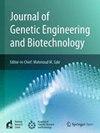从医学上重要的雄蛾物种毒液的酶特性和蛋白质组学分析
IF 2.8
Q3 Biochemistry, Genetics and Molecular Biology
Journal of Genetic Engineering and Biotechnology
Pub Date : 2025-09-10
DOI:10.1016/j.jgeb.2025.100566
引用次数: 0
摘要
埃及蝎属(蝎科)由于其神经毒性毒液产生危及生命的刺。然而,其毒液的组成和酶活性仍然知之甚少:我们使用电泳分析了三种雄蛾的毒液的蛋白质成分:amoreuxi雄蛾,australis雄蛾和双色雄蛾。质谱分析进行表征肽存在于这些毒液。检测了毒液的磷脂酶A2 (PLA2)、透明质酸酶和蛋白酶活性,以评估它们对毒液毒性的潜在贡献。最后,对毒液的抗菌和溶血活性进行了评价。三种毒液的电泳图谱显示出每个物种特有的特征,在75、74、67、48、46、40和28 kDa处观察到不同的蛋白质条带,并在15 kDa标记以上观察到显著的条带。采用液相色谱/质谱分析方法,分别检测到amoreuxi、A. australis和A. bicolor毒液中存在369、324和351种分子质量在500 ~ 10000 Da范围内的成分。在所有毒液样品中均检测到丰富的二硫肽(3个二硫桥),但也检测到不含二硫键的肽。所有三种毒液都显示出透明质酸酶活性,而蛋白酶和PLA2活性要么很弱(在1µg和10µg时),要么无法检测到,即使在较高浓度(高达20µg)下也是如此。所有检测均使用按干重标准化的毒液进行,以确保蛋白质数量一致。粗毒液对大肠杆菌和枯草芽孢杆菌的抑菌活性为5 ~ 10 μg,对双色拟南芥的抑菌活性为10 μg。疏水部分(40-55 min)单独的南胡麻保持这种活性。这项工作进一步加深了我们对雄蛾毒液的酶和肽组成的了解,揭示了它们在药物输送增强和其他生物医学应用方面的潜力。这些发现将为蝎子中毒的治疗和预防提供更好的策略。本文章由计算机程序翻译,如有差异,请以英文原文为准。
Enzymatic characterization and proteomic profiling of venoms from the medically important Androctonus species
Egyptian scorpions of the Androctonus genus (family Buthidae) produce life-threatening stings owing to their neurotoxic venom. However, the composition and enzymatic activities of their venoms remain poorly understood: We used electrophoresis to analyze the protein components of venoms collected from three Androctonus species: Androctonus amoreuxi, Androctonus australis, and Androctonus bicolor. Mass spectrometric analysis was performed to characterize the peptides present in these venoms. The phospholipase A2 (PLA2), hyaluronidase, and protease activities of the venoms were examined to gauge their potential contribution to venom toxicity. Finally, the antibacterial and hemolytic activities of the venoms were evaluated. The electrophoretic profiles of the three venoms showed features specific to each species, with distinct protein bands observed at 75, 74, 67, 48, 46, 40, and 28 kDa, along with a notable band above the 15-kDa mark. Liquid chromatography/mass spectrometry analyses were used to detect the presence of 369, 324, and 351 components in with molecular masses in the range of 500–10,000 Da in the venoms of A. amoreuxi, A. australis, and A. bicolor, respectively. Disulfide-rich peptides (three disulfide bridges) were abundant, but peptides without disulfide bonds were also detected in all venom samples. All three venoms exhibited hyaluronidase activities, whereas protease and PLA2 activities were either weak (at 1 µg and 10 µg) or undetectable, even at higher concentrations (up to 20 µg). All assays were performed using venoms standardized by dry weight to ensure consistent protein quantities. Crude venoms of A. amoreuxi and A. australis showed antibacterial activity against E. coli and B. subtilis (5–10 μg), whereas A. bicolor required 10 μg. Hydrophobic fractions (40–55 min) of A. australis alone retained this activity. This work furthers our knowledge of the enzymatic and peptide composition of Androctonus venoms, unveiling their potential in drug delivery enhancement and other biomedical applications. These findings will inform the development of better strategies for the treatment and prevention of scorpion envenomation.
求助全文
通过发布文献求助,成功后即可免费获取论文全文。
去求助
来源期刊

Journal of Genetic Engineering and Biotechnology
Biochemistry, Genetics and Molecular Biology-Biotechnology
CiteScore
5.70
自引率
5.70%
发文量
159
审稿时长
16 weeks
期刊介绍:
Journal of genetic engineering and biotechnology is devoted to rapid publication of full-length research papers that leads to significant contribution in advancing knowledge in genetic engineering and biotechnology and provide novel perspectives in this research area. JGEB includes all major themes related to genetic engineering and recombinant DNA. The area of interest of JGEB includes but not restricted to: •Plant genetics •Animal genetics •Bacterial enzymes •Agricultural Biotechnology, •Biochemistry, •Biophysics, •Bioinformatics, •Environmental Biotechnology, •Industrial Biotechnology, •Microbial biotechnology, •Medical Biotechnology, •Bioenergy, Biosafety, •Biosecurity, •Bioethics, •GMOS, •Genomic, •Proteomic JGEB accepts
 求助内容:
求助内容: 应助结果提醒方式:
应助结果提醒方式:


